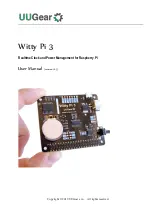
Chapter 2
– Installation
14
FCM II Installation Guide: 20160419 - Part # 2307
!
!
The installer should provide over current protection between the branch circuit and the supply according to the
power supply manufacturer’s recommendations; usually either an appropriately sized slow-blow fuse or a
characteristic B thermal magnetic circuit breaker. Because the primary side of the power supply is overcurrent
protected, it is not necessary to fuse the 24 Vdc output, unless it is used to supply power to field devices located
outside of the panel housing the FCM IIs.
Note 1: If a disconnecting device is used, ensure that it is not blocked by FCMs or any other
device which would make it difficult to operate. If used, do not place the disconnect in a
Class I, Division 2 location.
Note 2: Do not place a thermal magnetic circuit breaker in a Class I, Division 2 location.
2.5
S
ERIAL
C
OMMUNICATION
C
ONNECTION
RS-422/485 communications protocol is designed for multi-point (i.e. computer to multiple devices, also called
multi-dropped) communications up to 4,000 feet (1,220 Meters).
RS-422 requires 4-wires (2 twisted pair) for full duplex communications and utilizes a transmit pair of wires (TDA
& TDB) and a receive pair of wires (RDA & RDB).
Figure 2.4 shows the terminal assignments for the bus RS-485 serial connection. Either end may be connected
to a MultiLoad or other serial device as the bus supplies the serial connection to all modules that are joined
together. The TD and RD pairs are swapped at the MultiLoad II. Although the ten position terminal block is rated
for 14 to 30 AWG [2.1 to 0.05 mm
2
], a reliable serial connection will be achieved by the use of cable meeting the
following:
24 AWG [0.2 mm
2
] stranded.
4-wire, two twisted pair with overall shield.
30 pF maximum between conductors.
1,000 ohm impedance.
Maximum length: 4,000 feet (1,220 Meters)
Maximum stub length: 15 feet.
All exposed shields must be properly insulated to prevent short circuits.
All shields must be continuous, soldered and properly insulated.















































